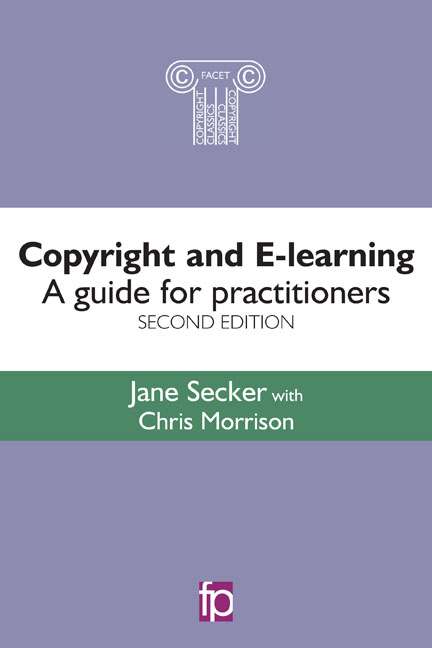Book contents
- Frontmatter
- Contents
- Figures, tables and case studies
- Preface to the second edition
- Introduction
- Abbreviations and acronyms
- Glossary
- 1 E-learning and copyright: background
- 2 Digitizing text-based content for delivery in a VLE
- 3 Using digital media: video, images, sound and software
- 4 Copyright issues and born digital resources
- 5 Copyright in the connected digital environment
- 6 Copyright education and training
- 7 Conclusion
- Further resources
- Index
Introduction
Published online by Cambridge University Press: 08 June 2018
- Frontmatter
- Contents
- Figures, tables and case studies
- Preface to the second edition
- Introduction
- Abbreviations and acronyms
- Glossary
- 1 E-learning and copyright: background
- 2 Digitizing text-based content for delivery in a VLE
- 3 Using digital media: video, images, sound and software
- 4 Copyright issues and born digital resources
- 5 Copyright in the connected digital environment
- 6 Copyright education and training
- 7 Conclusion
- Further resources
- Index
Summary
Material on the subjects of copyright and e-learning is essential reading for those working in education today. Whether you are a staff development officer, a teacher or an administrator, digital technology and the internet will have impacted on the way in which you work. This impact has been felt in both formal and informal learning in school classrooms and staff development units, in almost all educational establishments in the last 15 years. Information and communication technologies (ICTs) have offered teachers new ways of finding, creating and distributing content to learners, extending the physical classroom to include some form of digital space in which teachers can place resources. Educational technologies provide students with new ways of completing assignments, new types of assignments and new ways of interacting with their teachers and peers; learners who study at a distance from their institution can discuss ideas using online forums or can work together on projects using a collaborative writing tool such as a wiki. The development of ICTs has provided students with access to learning and resources at a time and place convenient to them. Those working in student and staff support, in libraries, IT, training and educational development have perhaps seen the greatest changes, with the creation of new roles and responsibilities specializing in educational technologies. Increasingly both learners and teachers are working in what is described as a new learning environment, a description that makes reference to the digital or virtual space.
The classroom of the 21st century often has integrated technology such as smartboards, wireless networks, recording and lecture capture tools. Our learners increasingly use technology in the classroom, bringing with them laptops, smartphones and tablets with in-built cameras and recording devices, leading them to have different expectations, skills and experience from students of the past. Thus, as the teaching and learning environment changes, so too does the way we teach. However, in this new and exhilarating world of online teaching and learning, copyright is often an issue that is overlooked, or perhaps considered as an afterthought. Whereas online learning is seen as fun and exciting, copyright is perceived as being boring and restrictive; it can be perceived as a barrier that stops teachers putting into practice their teaching innovations. For those charged with offering copyright advice, it can sometimes seem as though they are the person inhibiting exciting new developments.
- Type
- Chapter
- Information
- Copyright and E-learninga guide for practitioners, pp. xv - xxviPublisher: FacetPrint publication year: 2016



